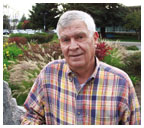|
Web Exclusives: Alumni Spotlight
January 25, 2006: PROFILE When the earth shakes, the media report how high the temblor registered on the Richter scale. But despite its frequent use, the famous rating system created by Charles Richter in 1935 is no longer how seismologists gauge the size of earthquakes. They actually use a scale invented in 1979 by Thomas Hanks ’66 and a colleague, Hiroo Kanamori, known as the moment-magnitude scale. Like its better-known counterpart, the scale developed by Hanks and Kanamori rates earthquakes by their size, or magnitude, but the moment-magnitude-scale calculations are far more reliable for large seismic events. The U.S. Geological Survey adopted the moment-magnitude scale as its standard in 2000. Because the new system sounds just like the old scale, most reporters don’t know they are citing the wrong scale. “Every magnitude you see these days is a moment-magnitude,” says Hanks. For Hanks, a geophysicist with the U.S. Geological Survey in Menlo Park, Calif., the moment-magnitude scale is just one of a series of quiet contributions made over a 33-year career that have helped scientists understand why earthquakes occur. A geological engineering major at Princeton, Hanks developed his fascination with quakes after witnessing firsthand, as a graduate student at the California Institute of Technology, the devastating 1971 San Fernando earthquake in Los Angeles — which leveled buildings and claimed 65 lives. Since then, Hanks has studied the causes and effects of earthquakes in New Zealand, Mongolia, Mexico City, China, and miles deep in South African gold mines. In 1981, Hanks and another colleague also developed a more accurate way to describe how a quake’s energy will materialize as strong ground motion, helping engineers design buildings that can withstand the most vigorous shaking they can expect during the buildings’ lifetimes. The most important location Hanks has analyzed for seismic safety is the designated federal site for nuclear-waste disposal at Yucca Mountain in Nevada. For two years, he chaired a committee whose job it was to predict how much the ground around the repository would move when very rare earthquake ground motion occurs — that is, ground motion that might happen once in 100 million years. “A hundred million years is a long, long time,” Hanks says, “and we are only beginning to understand the things that the earth can do over such time intervals.” When the next earthquake takes place, and the media scramble to
report the latest readings on the “Richter scale,” Hanks
won’t mind letting his credit go elsewhere. “Charles
Richter is one of the great saints in the field of seismology, and
I don’t want to get in his way at all,” Hanks says.
Besides, the “Hanks-Kanamori scale” just doesn’t
have the same ring. By Justin Nyberg ’01 Justin Nyberg ’01 is a writer for Outside magazine in Santa Fe, N.M.
|
||

